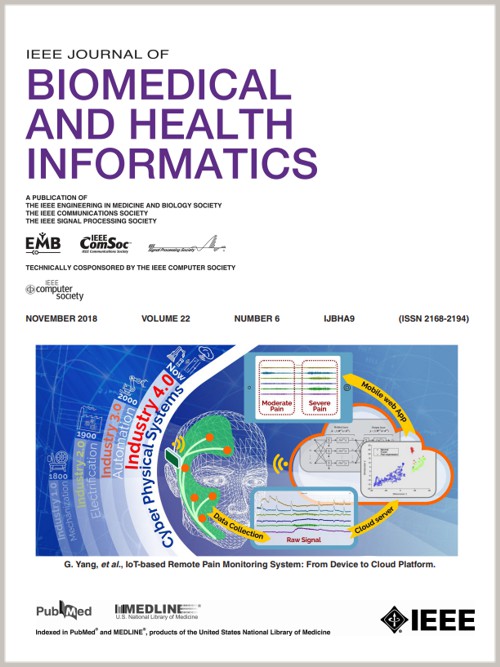基于传感器的人类活动识别:创新的双解耦(Dual-Decoupling)CNN与分层时空关注(Layer-wise Temporal-Spatial Attention)。
IF 6.7
2区 医学
Q1 COMPUTER SCIENCE, INFORMATION SYSTEMS
IEEE Journal of Biomedical and Health Informatics
Pub Date : 2024-10-30
DOI:10.1109/JBHI.2024.3488528
引用次数: 0
摘要
人类活动识别(HAR)对于监测和分析人类行为至关重要,尤其是在跌倒检测和慢性病管理等健康应用领域。传统的方法,即使是包含注意力机制的方法,也常常通过统一处理特征来过度简化传感器数据中复杂的时间和空间依赖关系,从而导致对高维交互的建模不足。为了解决这些局限性,我们提出了一个新颖的框架:具有分层训练卷积神经网络的时空特征解耦单元(CNN-TSFDU-LW)。我们的模型通过解耦时间和空间依赖关系来提高 HAR 的准确性,从而促进更精确的特征提取并减少计算开销。TSFDU 机制可以并行处理时间和空间特征,从而丰富所学的表征。此外,利用局部误差函数进行的分层训练允许对每个 CNN 层进行独立更新,从而在不影响性能的情况下减少了参数数量并提高了内存效率。在四个基准数据集(UCI-HAR、PAMAP2、UNIMIB-SHAR 和 USC-HAD)上进行的实验表明,与最先进的方法相比,我们的准确率提高了 0.9% 到 4.19%,同时还降低了计算复杂度。具体来说,我们的框架在 UCI-HAR 中的准确率达到 97.90%,在 PAMAP2 中的准确率达到 94.34%,在 UNIMIB-SHAR 中的准确率达到 78.90%,在 USC-HAD 中的准确率达到 94.71%,突出了其在复杂 HAR 任务中的有效性。总之,CNN-TSFDU-LW 框架在基于传感器的 HAR 方面取得了重大进展,既提高了准确性,又提高了计算效率,有望增强健康监测应用。本文章由计算机程序翻译,如有差异,请以英文原文为准。
Innovative Dual-Decoupling CNN With Layer-Wise Temporal-Spatial Attention for Sensor-Based Human Activity Recognition
Human Activity Recognition (HAR) is essential for monitoring and analyzing human behavior, particularly in health applications such as fall detection and chronic disease management. Traditional methods, even those incorporating attention mechanisms, often oversimplify the complex temporal and spatial dependencies in sensor data by processing features uniformly, leading to inadequate modeling of high-dimensional interactions. To address these limitations, we propose a novel framework: the Temporal-Spatial Feature Decoupling Unit with Layer-wise Training Convolutional Neural Network (CNN-TSFDU-LW). Our model enhances HAR accuracy by decoupling temporal and spatial dependencies, facilitating more precise feature extraction and reducing computational overhead. The TSFDU mechanism enables parallel processing of temporal and spatial features, thereby enriching the learned representations. Furthermore, layer-wise training with a local error function allows for independent updates of each CNN layer, reducing the number of parameters and improving memory efficiency without compromising performance. Experiments on four benchmark datasets (UCI-HAR, PAMAP2, UNIMIB-SHAR, and USC-HAD) demonstrate accuracy improvements ranging from 0.9% to 4.19% over state-of-the-art methods while simultaneously reducing computational complexity. Specifically, our framework achieves accuracy rates of 97.90% on UCI-HAR, 94.34% on PAMAP2, 78.90% on UNIMIB-SHAR, and 94.71% on USC-HAD, underscoring its effectiveness in complex HAR tasks. In conclusion, the CNN-TSFDU-LW framework represents a significant advancement in sensor-based HAR, delivering both improved accuracy and computational efficiency, with promising potential for enhancing health monitoring applications.
求助全文
通过发布文献求助,成功后即可免费获取论文全文。
去求助
来源期刊

IEEE Journal of Biomedical and Health Informatics
COMPUTER SCIENCE, INFORMATION SYSTEMS-COMPUTER SCIENCE, INTERDISCIPLINARY APPLICATIONS
CiteScore
13.60
自引率
6.50%
发文量
1151
期刊介绍:
IEEE Journal of Biomedical and Health Informatics publishes original papers presenting recent advances where information and communication technologies intersect with health, healthcare, life sciences, and biomedicine. Topics include acquisition, transmission, storage, retrieval, management, and analysis of biomedical and health information. The journal covers applications of information technologies in healthcare, patient monitoring, preventive care, early disease diagnosis, therapy discovery, and personalized treatment protocols. It explores electronic medical and health records, clinical information systems, decision support systems, medical and biological imaging informatics, wearable systems, body area/sensor networks, and more. Integration-related topics like interoperability, evidence-based medicine, and secure patient data are also addressed.
 求助内容:
求助内容: 应助结果提醒方式:
应助结果提醒方式:


